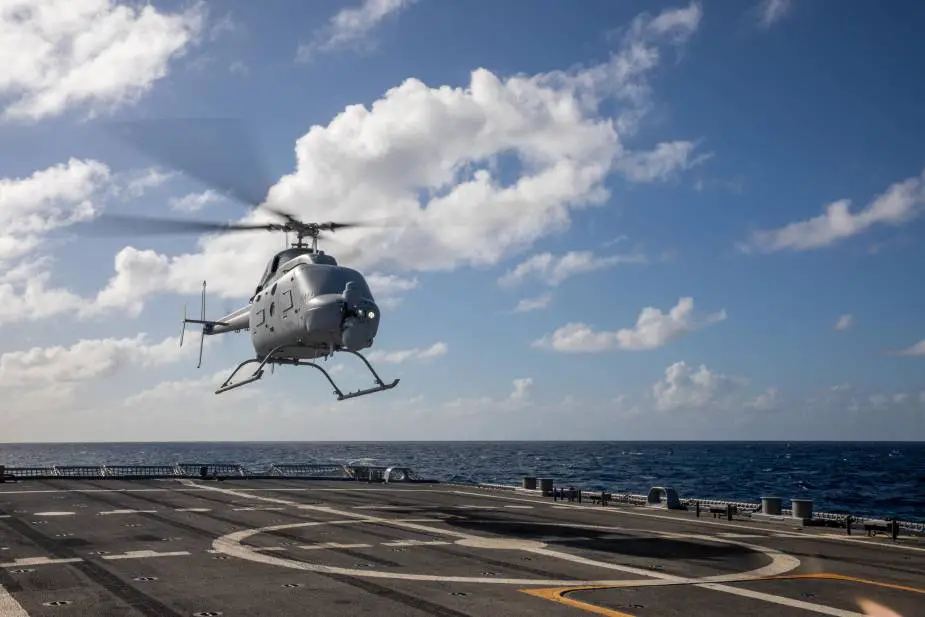Breaking news
US Navy conducts flight operations with MQ-8C unmanned helicopter from Littoral Combat Ship.
According to pictures released on the official website of the U.S. Navy on January 6, 2022, the U.S. Navy has conducted flight operations with the MQ-8C Fire Scout unmanned helicopter from the Freedom-variant littoral combat ship USS Milwaukee LCS 5 to support Joint Interagency Task Force South’s mission, which includes counter-illicit drug trafficking missions in the Caribbean and Eastern Pacific.
Follow Navy Recognition on Google News at this link
 An MQ-8C Fire Scout attached to the “Sea Knights” of Helicopter Sea Combat Squadron (HSC) 22, Detachment 5, takes off from the flight deck of the Freedom-variant littoral combat ship USS Milwaukee (LCS 5), January 6, 2022. (Picture source U.S. Navy)
An MQ-8C Fire Scout attached to the “Sea Knights” of Helicopter Sea Combat Squadron (HSC) 22, Detachment 5, takes off from the flight deck of the Freedom-variant littoral combat ship USS Milwaukee (LCS 5), January 6, 2022. (Picture source U.S. Navy)
The USS Milwaukee (LCS-5) is a Freedom-class littoral combat ship in service with the United States Navy. The ship is a semi-planning steel monohull with an aluminum superstructure. She has a length of 115 m, displaces 3,500 metric tons, and can reach a top speed of 47 knots (87 km/h). The design incorporates a large, reconfigurable sea frame to allow rapidly interchangeable mission modules, a flight deck with an integrated helicopter launch, recovery, and handling system, and the capability to launch and recover boats (manned and unmanned) from both the stern and side. The rear of the ship has a flight deck and one hangar which can accommodate one MH-60R/S Seahawk, two MQ-8B, or one MQ-8C Fire Scout.
The MQ-8C Fire Scout is an unmanned helicopter developed by the American company Northrop Grumman for use by the United States Navy. It has autonomous take-off and landing capability. This unmanned helicopter is designed to provide reconnaissance, situational awareness, aerial fire support, and precision targeting support for ground, air, and sea forces.
The use of unmanned vehicles is viewed as a key element of the effort to transform U.S. military forces. Citing Admiral M.M. Gilday, U.S. Chief of Naval Operations, as the U.S. Navy adapts to an increasingly complex security environment, it is imperative that we understand what our future force will need to operate both in day-to-day competition as well as a high-end fight.
Unmanned Systems have and will continue to play a key part in future Distributed Maritime Operations (DMO), and there is a clear need to field affordable, lethal, scalable, and connected capabilities. That is why the U.S. Navy is expanding and developing a range of unmanned aerial vehicles (UAV), unmanned undersea vehicles (UUV), and unmanned surface vessels (USV) that will play key roles as we shift our focus toward smaller platforms that operate in a more dispersed manner.
In July 2019, the U.S. Navy declared its MQ-8C Fire Scout unmanned helicopter mission capable and ready to deploy aboard Littoral Combat Ships. On February 2, 2021, Northrop Grumman Corporation and UK-based Ultra equipped an MQ-8C Fire Scout with Ultra sonobuoys, receiver and processor conducted an unmanned aircraft systems (UAS) anti-submarine warfare (ASW) capability demonstration.
The MQ-8C Fire Scout can fly missions in excess of 12 hours, providing commanders an unrivaled level of layered multi-source/sensor intelligence, surveillance, reconnaissance (ISR) and command and control/communication relay capabilities over land and sea. When operating in a manned-unmanned teaming concept, Fire Scout enables commanders to employ manned assets in a more focused manner, allowing them to exploit hybrid manned/unmanned teaming opportunities.




























